
| The History Of Pontypridd | |
| It's often assumed that Pontypridd's town history began with the building of William Edwards bridge over the Taff River in 1756. Yet, although the bridge's aesthetic and architectural excellence did attract many visitors, it had little impact on its immediate surroundings. Indeed, it wasn't until the opening of the Glamorganshire Canal in 1794 that the rural character of the district witnessed significant development. | |
Plan of the Glamorgan Canal (highlighted in blue) 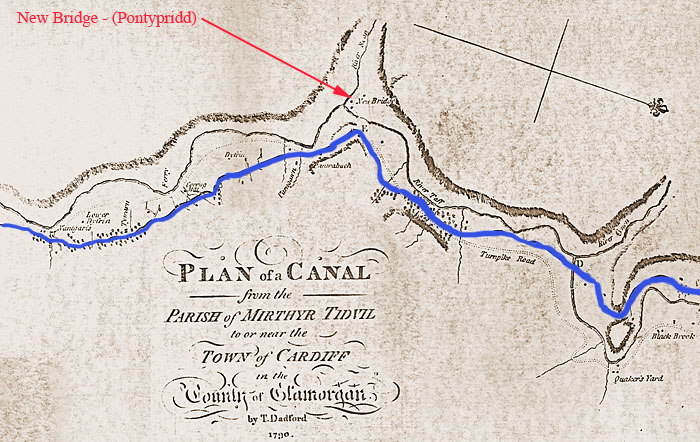 |
|
| However, it was the village of Treforest rather than Pontypridd that experienced the preliminary phase of industrialisation. By the end of the first decade of the nineteenth century a tinworks and small ironworks were in operation there . Treforest was also the terminus of a tramroad constructed by Dr Richard Griffiths that ran from the first coalmines being sunk in the lower Rhondda. Dr Griffiths also built a private canal known as the Doctor's Canal that linked the tramroad and the Glamorganshire Canal. Significantly, both the Doctor's Canal and tramroad effectively ignored the tiny hamlet scattered around Edwards's bridge and it wasn't until the arrival of the Brown Lenox chainworks in 1818 that Pontypridd experienced development of real significance. | |
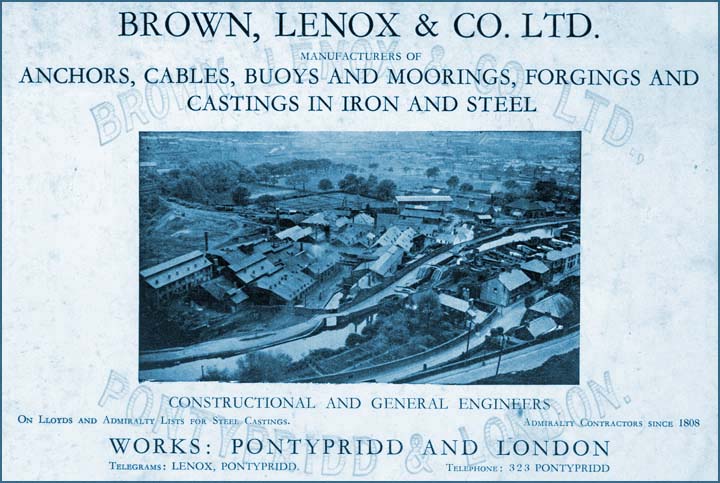 |
|
As the nineteenth century progressed, Pontypridd gradually began to replace Treforest as the district's commercial centre. Pigott's Directory of 1835 illustrates this change noting that a market was held in Pontypridd but no reference is made to one at Treforest. A significant boost to Pontypridd's development was the opening of the Taff Vale Railway that ran from Cardiff to Merthyr in 1841. Significantly, the railway station, unlike the canal, was situated on the Rhondda side of the valley. A massive expansion of the coal industry was about to commence and Pontypridd being at the front door to the coalfield was ideally placed to benefit. On the other hand, Treforest began to lose its momentum as a consequence of not having coalmines in its immediate vicinity. |
|
Railway Timetable showing the change of name that occured in 1866 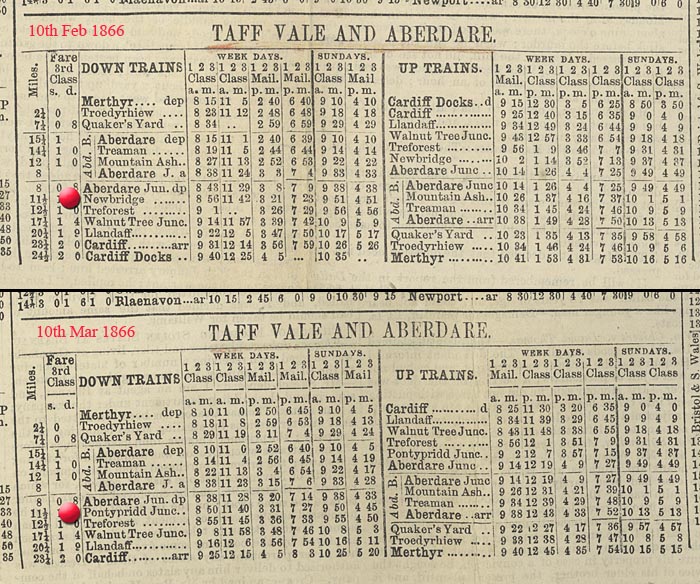 |
|
According to the 1841 census Pontypridd's population was around 2,500 while Treforest remained under a 1,000. Significant development had occurred between the hamlet surrounding Edwards's bridge and Pontypridd Railway Station as well as alongside the railway line and tramroad that ran parallel to each other. Taff Street had emerged as the town's main marketing street and all other identified streets on the 1841 census were also located on the western side of the Taff River including High Street, Mill Street, Crossbank Street, Market Street and Bridge Street. Development was also in evidence in Trallwn, Ynysangharad and Coedpenmaen located on the eastern side of the Taff River. The inhabitants of these areas as well as slightly further afield in Gwerngerwn, Glyntaff and Penterbach were very much dependent on the canal, chainworks and nearby quarries for their employment. Right: A sketch of Taff Street |
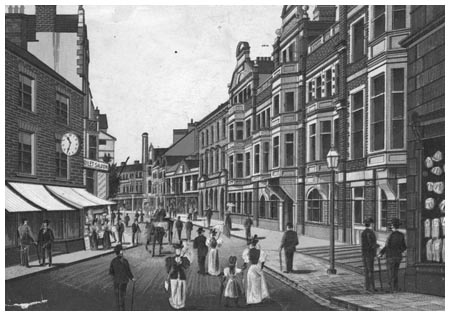 |
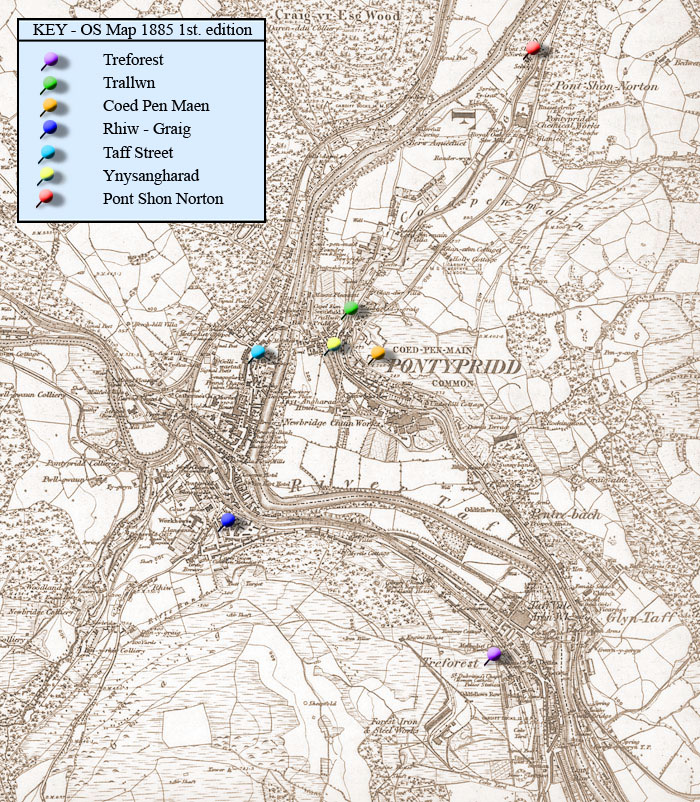 |
|
| Pontypridd's population continued to increase over the next three decades and had reached around 6,000 by 1871. The census of that year and the 1875 ordnance survey map show that the number of identified streets had increased to include among others Morgan Street, Union Street and Rickards Street. The town was gradually expanding outwards and now incorporated areas such as Rhiw, later known as the Graig , and Pontshonnorton. We also gather from the 1875 map that the town contained five collieries, three breweries, woollen factories, brickworks, mills and a chemical works. Two companies that had been established and important to the town's development were the Pontypridd Gas and Light Company and the Pontypridd Water Works Company. | |
Naturally, Pontypridd was described as an “improving” or a “rising market town”. Not until the 1875 Worrall's Trade Directory was Pontypridd deemed to have established itself simply as a “market town”. During the 1850s a market of considerable proportion was being held on its present site with the district's produce being brought to the town on each Wednesday and Saturday. Nearly the whole of the shopping and other business of the Rhondda Valleys was done in Pontypridd and hundreds of people visited the town on market day when most made their purchases for the week. The market continued to prosper and in 1877 The Pontypridd Market and Town Hall Company was incorporated. One of the founder members was Charles Bassett who was a prominent figure in the commercial and public life of mid nineteenth century Pontypridd. It was in his role as postmaster that Bassett in 1856 became instrumental in getting the town's name changed from Newbridge to Pontypridd. Right: Plans to extend the indoor market |
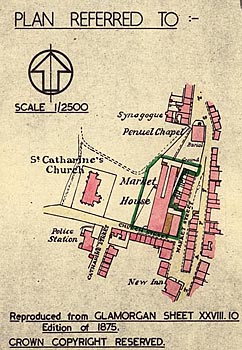 |
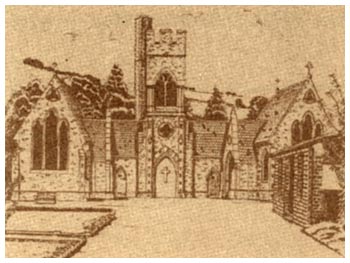 |
As the town's business and population increased, Pontypridd became the focus for the district's institutions of law and order. As early as 1839 the town had acquired its own police force. From 1851 a county court met at the White Hart Hotel until a Court House was built in 1869. The formation Pontypridd Poor Union in 1863 and the building of Pontypridd workhouse two years later was another means of controlling the social behaviour of the town's expanding working class. Pontypridd, in the words of Professor Meic Stephens, “was becoming a place with its own municipal apparatus and one of some importance”. A municipal cemetery was opened in 1871 at Glyntaf. The town's first newspaper, The Pontypridd District Herald, was established in 1873, followed by The Pontypridd Chronicle and, in 1897, The Pontypridd Observer, still published today. Pontypridd Rugby Club was formed in 1875. Left: Glyntaf |
| As Pontypridd entered the two decades of the nineteenth century the pace and extent of its growth was about to increase dramatically. According to the 1881 census the town's population remained below 8,000. By 1891 it had increased to 13,000 and to 20,000 by 1901. Small wonder that the town's Member of Parliament Alfred Thomas said in a speech when opening the municipal buildings in April 1906: “fifty years ago Pontypridd was smaller than any of its suburbs. When we compare or rather when we contrast the picture we draw in our mind's eye with that which we see today we are reminded more of the abnormal growth of some new world town say in the United States”. The town's population continued to increase into the twentieth century at a striking rate and peaked at the 1921 census. | |
The reason for Pontypridd's phenomenal growth can be attributed to the equally phenomenal growth of deep-seam coal mining. Previously, coal mining was a small-scale operation with small labour forces. Deep-seam mining allowed the development of large-scale labour intensive enterprises. The first mines to extract deep seam coal were located at the Great Western Colliery, Hopkinstown and the Albion Colliery, Cilfynydd. Although these were bordering villages demand for labour was so great that building activity proceeded quickly in the town itself in an attempt to keep pace with the need to house workers. The Maritime Colliery was deepened to the steam coal seam in 1906 and also became the first pit in the South Wales Coalfield to have by-product coke ovens. As a result of the aforementioned collieries' expansion, Pwllgwaun, Maesycoed, Trallwn and the Graig were areas of Pontypridd that developed considerably as coal owners built row upon row of terraced housing. Right: Carmel Baptist Chapel |
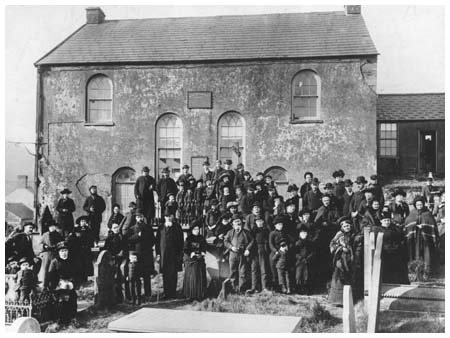 |
As well as houses for the working classes, impressive three storey houses were built around Graigwen and the Common to meet the need of the town's small but influential white collar class that included solicitors, accountants, teachers and businessmen. Pontypridd's industrial development went hand-in-hand with municipal growth. An Urban District Council based on six wards was formed in 1895 replacing a local board that had governed the town between 1875 and 1895. The council had a number of statutory undertakings and provided its ratepayers with electricity, gas and transport services, in addition to public libraries, a park and recreation grounds and an open-air swimming bath. An electric tram service that started at Treforest and extended through the town to Cilfynydd and Trehafod commenced in March 1905 and ran for 25 years before being replaced by trolleybuses. |
|
Below: A Tram in Pontypridd 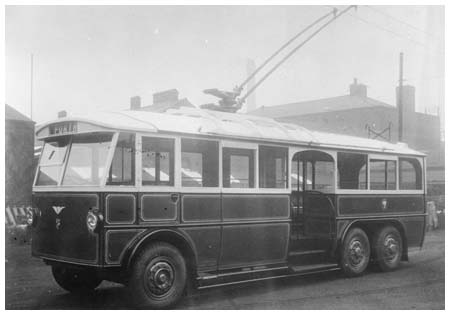 |
|
A generating station was built in Treforest to power the service and a large gasworks had been erected nearby in 1894. Pontypridd Library opened in 1890 included a reading room, a lending library and a reference department. A School Board was formed the same year as the Urban District Council. A year later, Pontypridd County School opened with the help of financial donations from local collieries. At first, the school was a mixed one with accommodation for 180 pupils. Several temporary buildings were erected to meet the increased number of pupils and in 1913 a new school, for girls was established at Treforest. The School Board was replaced by the Local Education Committee that consisted of 12 members of the PUDC and four members selected by the council, one of which was to be a woman. The town's industrial development not only led to municipal growth but it also resulted in cultural changes and the decline of the Welsh language. Before the sinking of the deep seam collieries, a substantial proportion of those attracted to Pontypridd to find work came from parts of rural Glamorgan and other rural Welsh counties. This initial influx resulted in the building of Nonconformist chapels were Welsh was the language of worship. Howell Harris had probably first kindled the Nonconformist flame in Pontypridd when he visited in 1739 but not until 1810 was Carmel Baptist Chapel built, the first place of worship erected in the town. The first Calvinistic Methodist Chapel was Penuel in Taff Street built in 1833. Neither chapel remains standing today. Sardis Chapel, a congregational chapel, was built in 1834 and remains the only chapel were the Welsh language thrives today. It's significant that there was no Anglican church with the town's boundaries during these early years. St Mary's Church, Glyntaff was established in 1843 but not until 1868 with the building of St Catherine's Church did Pontypridd have a church at the heart of the town. |
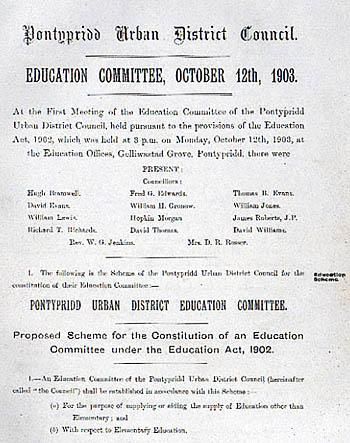 |
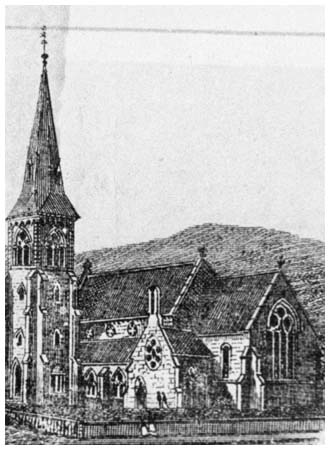 St. Marys Church, Glyntaf |
At the end of the nineteenth century, the building of several chapels around the town mirrored the town's period of rapid expansion. Further, English was the language of worship in many of these chapels and this reflected the fact that the majority of the town's immigrants now came from beyond Offal's Dyke. The culture of Non conformist chapels centred on the male voice choir, concerts and eisteddfodau. However by the beginning of the twentieth century it failed to satisfy the recreational needs of a growing number of the town's inhabitants. Several theatres and cinemas were built in the town. The Royal Clarence Theatre that was the first permanent theatre built in the South Wales Coalfield and could seat an audience of a thousand. A Town Hall situated at Pontypridd Market was built in 1885. The New Town Hall replaced it in importance with a seating capacity of 1,700. A wide range of sporting activities grew in popularity at the end of the nineteenth century. Boxing in particular was one sport that brought glory to Pontypridd. Frederick Hall Thomas, known as Freddie Welsh, was born in Morgan Street and became the world lightweight title in 1914. Another boxer in Pontypridd was Frank Moody who won the British Middleweight title in 1927. Ted E Lewis, Boxing promoter, manager and founder member of the original British Boxing Board of Control wrote in an article entitled ‘Pontypridd – Hub of Welsh Boxing Universe' “no town of its size can claim to home produced a world champion and a British Champion”. A venue for many sports was the Taff Vale Park in Treforest that included a banked cycle track, a cinder running area, playing fields and the only substantial grandstand to be found throughout the valleys. Among the vast array of sports activities held there was the Welsh Powderhall sprint championship established in 1903. Over its 26 year history it proved a substantial attraction for competitors and spectators alike.
|
| Since the 1921 census the population of Pontypridd has been in continual decline. The decline was particularly marked during the 20s and 30s. The town like many others in south Wales between the wars suffered from its dependence on coal. By 1929 south Wales, which had once supplied almost a third of the world's output of coal, now produced less than 3 per cent. The decision of British and other navies to change from coal to oil proved disastrous for Welsh steam coal exports. With the coalfield in crisis, the number of collieries in south Wales steadily diminished and those that remained became increasingly cost-conscious. In common with its neighbours, Pontypridd saw its prosperity dwindle and its population decline as many of its citizens were forced to seek a livelihood elsewhere. For many of those who remained unemployment and poverty became all too familiar. A significant development with the aim of bringing employment to the area was the establishment of the Treforest Trading Estate in 1936. By September 1939, 2,500 workers were employed at Treforest and between sixty to seventy firms in production. It played a vital wartime role, chiefly in connection with the aircraft industry, and has since been a teeming industrial centre. | 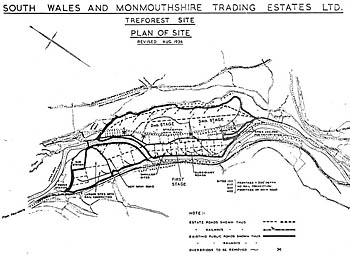 |
| Until recent years Pontypridd had a thriving shopping centre, attracting many people from other valleys, small towns and villages. The town regularly witnessed an influx of vast numbers of visitors. The exact numbers involved have never been precisely ascertained, but have been estimated as high as fifty thousand on a busy Saturday. Pontypridd was a social and recreational centre of considerable importance. One of the main problems resulting from the number of visitors was the tremendous congestion in the centre of the town. Despite the construction of the A470 and other road schemes, the town continues to suffer with traffic congestion as increasing number of people commute greater distances to work. A challenge Pontypridd now faces at the beginning of the twenty first century is whether to participate in wholesale redevelopment or withstand the growth of out of town shopping centres and opt instead for gradual refurbishment of original buildings, thereby retaining both Indoor and Outdoor Markets in their traditional style. | |